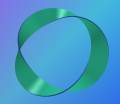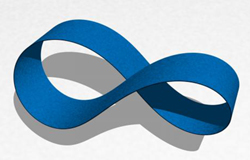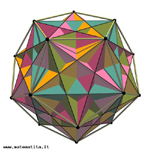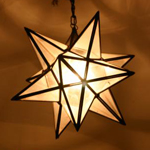 It is very easy to make a Moebius strip. You just need to take a paper rectangle, quite long and narrow (a convenient ratio between the edges can be 1:5), and glue the short edges after you give a half twist to the rectangle. You obtain a simple object which somehow looks like a cylinder, but it is very different from it.
It is very easy to make a Moebius strip. You just need to take a paper rectangle, quite long and narrow (a convenient ratio between the edges can be 1:5), and glue the short edges after you give a half twist to the rectangle. You obtain a simple object which somehow looks like a cylinder, but it is very different from it.
To begin with, you see that the boundary of a cylinder is made up by two circles. On the contrary, it is easy to realize (following it with a finger or, better, with a colour pencil) that the boundary of the Moebius strip is made up by just one circle.
 The Moebius strip is also characterized by its "non-orientability". If you imagine, like in this animation, to move on a Moebius strip, you get... on the other side after a full round. This characteristic may seem a property which is not intrinsic, but it depends on the way the Moebius strip "lies" in the space we live. In fact, that's what happens. We might imagine other three-dimensional spaces - different from the one we live in - where our Moebius strip has two sides. There, the little wheels which move on the Moebius strip would be always on one side.
The Moebius strip is also characterized by its "non-orientability". If you imagine, like in this animation, to move on a Moebius strip, you get... on the other side after a full round. This characteristic may seem a property which is not intrinsic, but it depends on the way the Moebius strip "lies" in the space we live. In fact, that's what happens. We might imagine other three-dimensional spaces - different from the one we live in - where our Moebius strip has two sides. There, the little wheels which move on the Moebius strip would be always on one side. 
This does not and can not happen in three-dimensional space because of an intrinsic property of the Moebius strip (precisely the non-orientability), which depends only on the surface and not on the space where it lies. Imagine, as in this animation to let something flat go around the Moebius strip - something that does not bulge out like a little wheel. Take, for instance, the drawing of a little glove. After a full round on the surface, a left glove turns into a right glove and the anticlockwise rotation which maps the forefinger on the thumb turns into a clockwise rotation. Clearly, this does not happen if we perform the same operation on a cylinder.
 There are other differences between a cylinder and a Moebius strip. If you cut a cylinder along a 'middle' circle, which goes around the cylinder, you get two cylinders. On the other hand, if you cut a Moebius strip along the middle circle, you are not able to separate it. Precisely, you get one object, which is 'equal' to a cylinder from a topological point of view. You may wonder what you get if you cut a Moebius strip into three parts or you may guess what happens if you identify two opposite edges of a rectangle after you give two, or three, or more half twists. Do we always get different objects or not? The answer is not so obvious. From the point of view of the intrinsic topology, all these objects are equal to a cylinder (if the number of half twists is even) or to a Moebius strip (if this number is odd). For example, all the objects with an even number of half twists are orientable (the others are not); they have two boundary components (the others have just one) and are separated into two parts if you cut them along the middle circle, which does not happen for the others.
There are other differences between a cylinder and a Moebius strip. If you cut a cylinder along a 'middle' circle, which goes around the cylinder, you get two cylinders. On the other hand, if you cut a Moebius strip along the middle circle, you are not able to separate it. Precisely, you get one object, which is 'equal' to a cylinder from a topological point of view. You may wonder what you get if you cut a Moebius strip into three parts or you may guess what happens if you identify two opposite edges of a rectangle after you give two, or three, or more half twists. Do we always get different objects or not? The answer is not so obvious. From the point of view of the intrinsic topology, all these objects are equal to a cylinder (if the number of half twists is even) or to a Moebius strip (if this number is odd). For example, all the objects with an even number of half twists are orientable (the others are not); they have two boundary components (the others have just one) and are separated into two parts if you cut them along the middle circle, which does not happen for the others.  What changes is the way in which these objects lie in three-dimensional space. In fact, it is impossible to take a cylinder and deform it till it assumes this configuration. One way to realize that this operation is impossible is to observe that the two circles, which make up the boundary, are not linked in the first case, but they are linkedin the second case.
What changes is the way in which these objects lie in three-dimensional space. In fact, it is impossible to take a cylinder and deform it till it assumes this configuration. One way to realize that this operation is impossible is to observe that the two circles, which make up the boundary, are not linked in the first case, but they are linkedin the second case.




